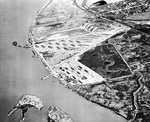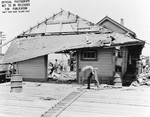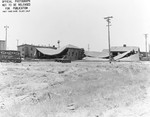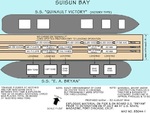Port Chicago Naval Munitions Explosion
Contributor: David Stubblebine
ww2dbasePort Chicago, California northeast of San Francisco on the shores of Suisun Bay was first settled by people of European ancestry in the 1850s in what was then called Bay Point but was renamed Port Chicago in 1931. With the United States' entry into World War II and the need to build-up military infrastructure, the Navy opened an ammunition embarkation facility at Port Chicago in 1942. Within the racially segregated Navy of the day, the dock workers were almost exclusively African-American sailors working under white officers. Their training had been in general cargo handling with little attention paid to how to specifically handle munitions. By 1944, ammunition bound for the Pacific Theater was being simultaneously loaded onto two munitions ships directly from railroad cars on the pier. With loading going on around the clock, a friendly competition between the work gangs developed that helped speed up the loading but further compromised some of the safety practices.
ww2dbaseOn the evening of 17 Jul 1944, cargo handlers were loading the Victory-ship SS Quinault Victory on one side of the pier and the Liberty-ship SS E.A. Bryan on the opposite side. Quinault Victory had just arrived that morning and loading was just beginning; E.A. Bryan had been at the pier for several days and loading was nearly complete. Between them, the ships were packed with roughly 5,000 tons of high explosives with another 400 tons on the pier in 16 rail cars. At 10:18 PM, for reasons that will never be known, Quinault Victory's load detonated in an enormous blast. A brilliant white flash shot into the air accompanied by a deafening boom. Smaller explosions continued and a few seconds later, the almost fully loaded E.A. Bryan detonated in one massive explosion. The seismic shock wave from that explosion was felt as far away as Boulder City, Nevada over 400 miles away. The E.A. Bryan and the structures around the pier were completely disintegrated. The largest remaining pieces of the 7,000-ton ship were the size of a suitcase. A pillar of fire and smoke stretched over two miles into the sky. A plane flying at 9,000 feet reported seeing pieces of white-hot metal "as big as a house" flying past. The broken hulk of the Quinault Victory was flung into the air and splashed back into the bay 500 feet away.
ww2dbaseAll 320 men on the ships and piers were killed instantly, 202 of whom were African-American enlisted men. The blast's shock wave smashed nearby buildings and rail cars and damaged every building in Port Chicago to one degree or another. People for miles around were sprayed with glass splinters and other debris. Hot metal and unexploded shells showered back to earth as far as two miles away. The blast even caused damage across the bay in San Francisco 25 miles away.
ww2dbaseNavy personnel quickly responded to the disaster. Men risked their lives to put out fires that threatened nearby munitions cars. Local emergency crews and civilians also rushed to help. In addition to the 320 killed, there were 390 wounded who needed tending to, some of whom were buried in the rubble.
ww2dbaseIn terms of lives lost and facilities destroyed, the Port Chicago Munitions explosion was the United States' worst home-front disaster of World War II and accounted for fifteen percent of all African-American casualties of the war. An analysis of the disaster helped to implement many safety improvements but the needs of the war still demanded hurried shipments of huge quantities of dangerous explosives so the risk was not completely eliminated.
ww2dbaseThree weeks after the explosion on 9 Aug 1944, the surviving members of the ordnance battalion were assigned to begin loading munitions again at nearby Mare Island. 258 African-American sailors told their officers that they would obey any other order, but not that one. 208 of them were court-martialed for disobeying orders while the other 50 faced the more serious charge of mutiny. Those charged with disobeying orders were sentenced to bad conduct discharges and the forfeiture of three month's pay. Since this was a time of war, the mutiny charge could have carried a death sentence but those sailors were given between eight and fifteen years at hard labor. Soon after the war, however, in Jan 1946, all of the men were given clemency. An official review of the proceedings in 1994 concluded the disciplinary process was badly flawed with strong overtones of racial bias. Future Supreme Court Justice Thurgood Marshall, who sat in on most of the 1944 proceedings, later said he believed there was prejudice within the court and a feeling the Navy saw the African-American sailors as more expendable, more disposable, than other sailors. On 23 Dec 1999, President Clinton granted a full pardon to Freddie Meeks, one of the few surviving members of the original 50 "mutineers." In 2019, by an act of Congress, all 50 sailors convicted of mutiny were officially exonerated.
ww2dbaseThe explosion, the subsequent mutiny proceedings, and the reluctance to undo those accusations for 75 years are still remembered as an illustration of the costs of racial discrimination imposed by a government that was, at the time, supposedly fighting for equality for all.
ww2dbaseSources:
United States Navy
United States Twelfth Naval District
United States National Parks Service
Contra Costa County Office of Education
Associated Press
San Francisco Chronicle
KRON-TV
Wikipedia
Last Major Update: Aug 2020
Port Chicago Naval Munitions Explosion Interactive Map
Photographs
 |  |  |  |
Maps
 |
Port Chicago Naval Munitions Explosion Timeline
| 17 Jul 1944 | The Liberty ship A. E. Bryan exploded whilst loading ammunition and explosives at Port Chicago, California, United States, taking with her the Victory ship Quinalt Victory berthed nearby. Ninety-seven men on the two ships were vapourised and even a 12 ton locomotive on the dockside vanished without trace. In total, 320 men were killed and 390 injured. More than 200 of the dead were black sailors being used as loaders. Later many sailors refused to work until safety was improved. Fifty were court martialed, convicted of mutiny and jailed. A public outcry led to their release but they were still deprived of all veteran's benefits for the rest of their lives. The last surviving "mutineer" Freddy Meeks was finally pardoned by President Bill Clinton in 1999. Four years later he died, aged 83. |
| 9 Aug 1944 | Following the Port Chicago munitions explosion, the surviving members of the ordnance battalion were assigned to resume loading munitions at nearby Mare Island. 258 African-American sailors told their officers that they would obey any other order, but not that one. All faced charges, 50 for mutiny. |
| 14 Sep 1944 | Court martial proceedings against 50 African-American sailors opened on Yerba Buena Island, San Francisco, California, United States. The 50 were charged with mutiny for refusing to resume loading munitions after the Port Chicago explosion of 17 Jul 1944. |
| 23 Dec 1999 | President Clinton granted a full pardon to Freddie Meeks, one of the few surviving members of the original 50 "mutineers" (Meeks was the only one of the 50 to formally apply for a pardon). |
| 17 Jul 2019 | 75 years after the Port Chicago explosion of 17 Jul 1944, by act of Congress, all 50 African-American sailors charged with mutiny following their refusal to resume loading munitions (all of whom had passed away) were fully exonerated of all charges and their records restored. |
Please consider supporting us on Patreon. Even $1 per month will go a long way! Thank you. Please help us spread the word: Stay updated with WW2DB: |

- » Wreck of Teruzuki Found (27 Jul 2025)
- » USS Orlean's Bow Found (22 Jul 2025)
- » The Emperor of Japan Planned to Honor WW2-era Japanese POWs in Mongolia (4 Jul 2025)
- » US State Lawmaker John Winter Caught Using Racial Slur "Jap" and Apologized (11 Jun 2025)
- » US Government Plans to Purge WW2 Information (17 Mar 2025)
- » See all news
 |
- » 1,182 biographies
- » 337 events
- » 45,119 timeline entries
- » 1,248 ships
- » 350 aircraft models
- » 207 vehicle models
- » 376 weapon models
- » 123 historical documents
- » 261 facilities
- » 470 book reviews
- » 28,409 photos
- » 365 maps
Fleet Admiral Chester W. Nimitz, 16 Mar 1945
Please consider supporting us on Patreon. Even $1 a month will go a long way. Thank you!
Or, please support us by purchasing some WW2DB merchandise at TeeSpring, Thank you!